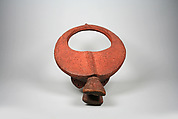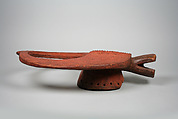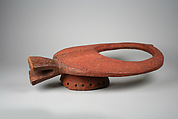Headdress: Bushcow (Mangam)
Not on view
The visual focus of this carved wood headdress are the distinctive flat horns evoking those of a bushcow. This central element consists of a median incised ridge flanked left and right by the horns, which are joined at the top to form a full circle. A small knot is indicated where the horns meet at the rear of the mask. A snout and open jaw project downward. The horns and snout surmount a concave dome, hollowed out to accommodate the head of the wearer.
South of the Jos plateau, the northernmost part of the Middle Benue Valley Region, headdresses such as this example are collectively identified as mangam. Worn during events directed at securing agricultural success, promoting healing, and marking rites of passage, they were part of a ritual complex bearing the same name. The full costume that hid the wearer’s body consisted of a dress of layered palm leaves, the upper-layer of which was attached directly to the holes along the mask's lower rim.
Mangam headdresses can bear references to three different bush animals: the bushcow (or dwarf forest buffalo, Suncerus caffer nanus), the waterbuck (Kobus ellipsiprymnus), and the reedbuck (redunca redunca). According to the late scholar Barbara Frank, the small hair knot at the rear of the mask and incisions along the central crest suggest a hybrid human-animal identity. The upper surface of the horns was often rubbed with powered red ochre, as this mask demonstrates clearly.
Further reading
Berns, Marla, "A Myriad of Mangam Masks." In Central Nigeria Unmasked: Arts of the Benue River Valley, pp. 406–15.
Frank, Barbara. "Kantana, Kulere, and Their Neighbors South of the Jos Plateau." In Central Nigeria Unmasked: Arts of the Benue River Valley, pp. 393–405.
Due to rights restrictions, this image cannot be enlarged, viewed at full screen, or downloaded.
This artwork is meant to be viewed from right to left. Scroll left to view more.




